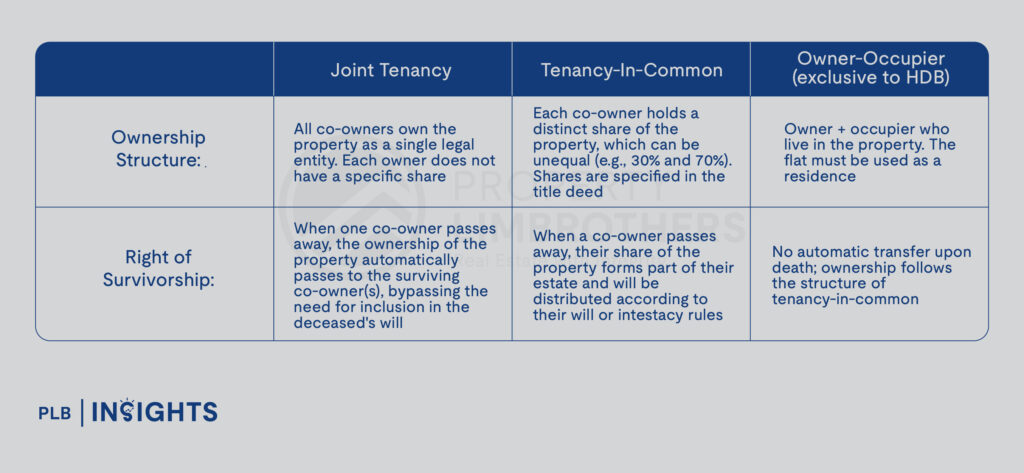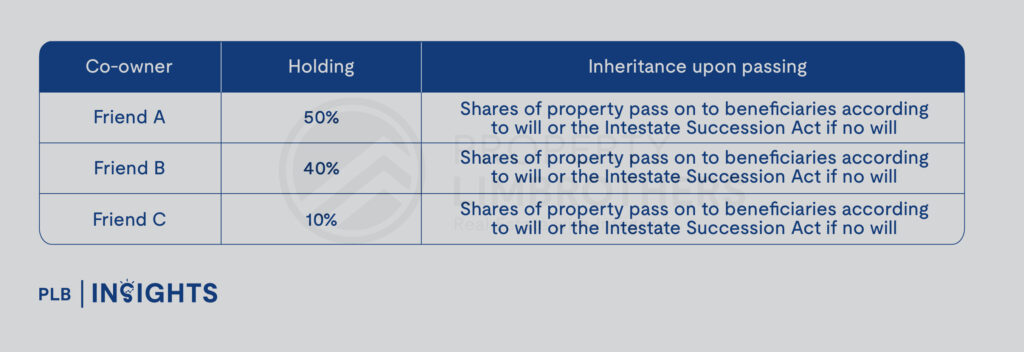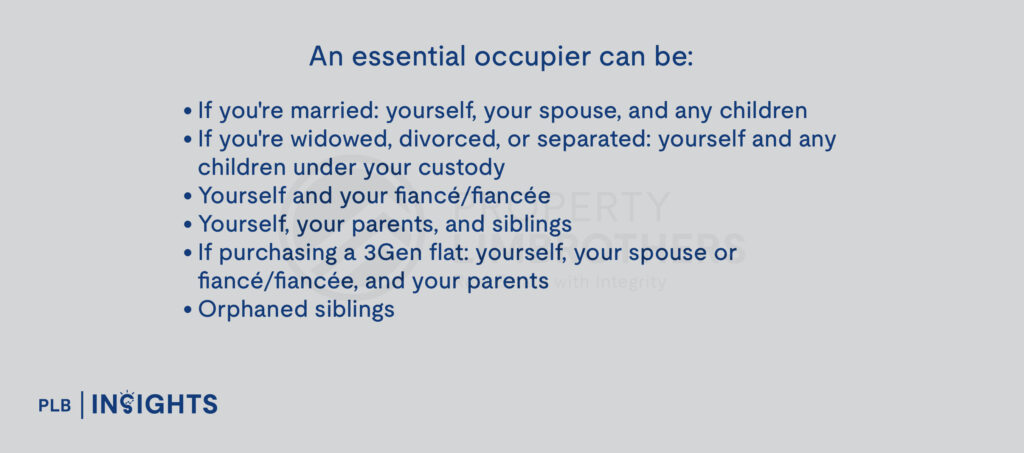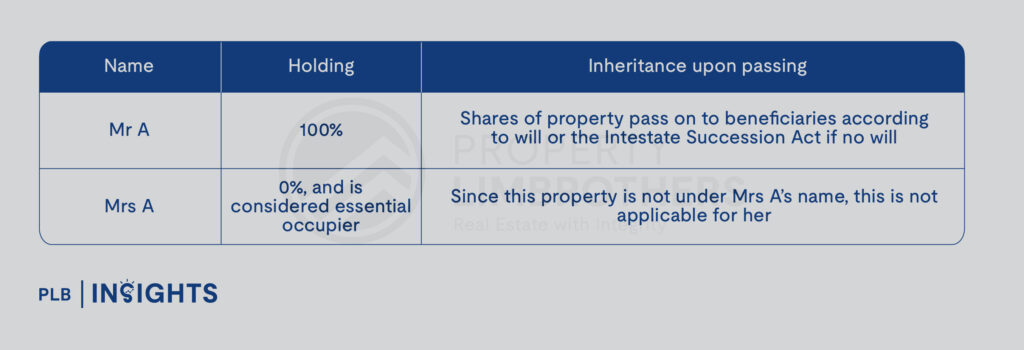
Whether you’re looking to buy property or already own one in Singapore, it’s important to know the different ways property ownership can be structured. In Singapore, properties such as HDB flats can be held in these main forms: Joint Tenancy, Tenancy-In-Common, as well as the Owner-Occupier scheme.
Understanding the Manner of Holding
Joint tenancy and tenancy-in-common are widely used options, but they come with unique characteristics and consequences. Joint tenancy includes the right of survivorship, meaning if one owner passes away, the remaining co-owner automatically inherits the entire property, regardless of any Will or the deceased owner’s wishes. In contrast, tenancy-in-common allows owners to hold unequal shares of the property and provides greater flexibility in how the property is distributed after an owner’s death. Meanwhile, the Owner-Occupier Scheme, specific to HDB flats, is made up of one owner and occupiers who live in the property, with specific eligibility requirements and implications for property tax and ownership rules.

Joint Tenancy
Take for example, if sister A, sister B, and their mother C decide to purchase an HDB flat together and choose to hold the property under joint tenancy, the arrangement ensures that upon the passing of mother C, her share of the flat will automatically be inherited by sisters A and B. Table 1 below shows a clear breakdown should any of them pass on.

In joint tenancy, ownership remains undivided, and the surviving co-owners inherit the deceased’s share without needing to go through probate.
Tenancy-in-Common
Now, let us look at an example under Tenancy-in-Common. Friend A, friend B, and friend C, who are friends, purchased a condo unit as an investment and opted for tenancy-in-common. They agreed to divide the shares based on each person’s financial contribution, with friend A owning 50%, friend B holding 40%, and friend C owning the remaining 10%. If friend A were to pass away, his/her 50% share would be transferred to his/her beneficiaries, while friend B and friend C would retain their 40% and 10% shares, respectively, alongside friend A’s beneficiaries. The same process would apply if friend B or friend C were to pass away.

Joint Tenancy vs Tenancy-In-Common
Joint tenancy is ideal for couples purchasing a home for their family. In fact, it is often the default arrangement when couples buy a residential property, as it ensures that the home will automatically transfer to the spouse. Similarly, a parent purchasing a property as an early inheritance for their child may also prefer joint tenancy, as it allows the property to be automatically passed to the child upon the parent’s passing.
On the other hand, tenancy-in-common is more suitable for friends investing in a property together, especially if each person contributes different amounts. This method allows co-owners to define distinct shares of the property, which can be passed on to their beneficiaries.
Singles buying an HDB flat together under the Joint Singles Scheme (JSS) might also consider opting for tenancy-in-common. Under the JSS, two or more single Singaporeans aged 35 or older can jointly purchase a resale HDB flat. Previously, the scheme permits singles to buy two-room flexi Build-to-Order (BTO) flats in non-mature estates, but starting from the October 2024 BTO sales exercise, they will be able to purchase such flats in any location.
Owner-Occupier Scheme for HDB
Now that we’ve compared Joint Tenancy and Tenancy-In-Common, it’s worth highlighting another scheme offered by HDB: the Owner-Occupier Scheme.
According to HDB, an essential occupier (or core occupier) is a family member listed in the Application Form to form a family nucleus, which is essential for qualifying under an eligibility scheme to purchase a flat. This applies to both new flats, such as Build-to-Order (BTO) units, and resale flats. The essential occupier plays a key role in meeting HDB’s eligibility requirements, which include ensuring that all applicants and occupiers listed in the flat application do not own other property, whether in Singapore or overseas, and have not disposed of any within the last 30 months. Additionally, essential occupiers must be immediate family members.

For example, Mr A and Mrs A are engaged and decided to buy a BTO flat, and they have decided to opt for the owner-occupier scheme: where Mr A is the owner while Mrs A is the essential occupier. In this case, Mr A owns 100% of the property, while Mrs A is deemed to not have this property under her name.

Why would one even consider this scheme? This scheme is particularly advantageous for those looking to acquire a second property after completing the Minimum Occupation Period (MOP) while minimising property taxes.
Back to using the case above. Adopting this scheme would free up Mrs A’s name from property ownership right from the onset. Only Mr A is listed as owner and will be deemed to have a property under his name.
So after fulfilling the MOP, Mrs A can actually purchase a private property without having to incur ABSD.
To note: However, if a couple currently owns a HDB under 50-50 Joint Tenancy, the couple would not be able to convert the manner of holding to an owner and essential occupier structure as HDB has tightened its share transfer regulation since 2016, except under these circumstances: divorce, demise of owner, bankruptcy, renunciation of citizenship, etc.
To provide a more comprehensive presentation, we’ve broken the essentials pros and cons in a table below:

For more details, please refer to the HDB website.
Final Thoughts
We have examined the three primary property holding arrangements—Joint Tenancy, Tenancy-in-Common, and the Owner-Occupier Scheme with the latter being exclusive to HDB flats. Understanding these different methods of holding property is crucial when making a purchase, as each comes with distinct legal and financial implications. Selecting the appropriate arrangement can greatly affect ownership rights, inheritance, and long-term property decisions.
Additionally, we explored the advantages and disadvantages of the Owner-Occupier Scheme, particularly for those planning to own both an HDB flat and a private property. This scheme is particularly relevant for those who want to own a HDB and private property in their property portfolio while potentially minimising tax liabilities associated with owning multiple properties.
Ultimately, choosing the right holding arrangement requires careful consideration of your individual circumstances, financial goals, and future plans. By understanding the various options, you can make informed decisions to optimise your property ownership experience in Singapore.
Our objective is to provide insightful and helpful content that can help you make informed decisions. Whether you’re a first-time homebuyer, an experienced investor, or just exploring your options, our team of consultants is here to guide and support you through every step of the process.
Disclaimer: Information provided on this website is general in nature and does not constitute financial advice
PropertyLimBrothers will endeavour to update the website as needed. However, information may change without notice and we do not guarantee the accuracy of information on the website, including information provided by third parties, at any particular time. While every effort has been made that the information provided is accurate, individuals must not rely on this information to make a financial or investment decision. Before making any, we recommend you consult a financial planner or your bank to take into account your particular financial situation and individual needs. PropertyLimBrothers does not give any warranty as to the accuracy, reliability or completeness of information which is contained in this website. Except insofar as any liability under statute cannot be executed, ProperyLimBrothers, its employees do not accept any liability for any error or omission on this website or for any resulting loss or damage suffered by the recipient or any other person.







